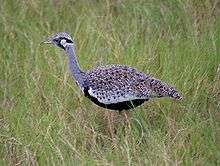Hartlaub's bustard
Hartlaub's bustard (Lissotis hartlaubii) is a species of bird in the family Otididae. Some authorities (such as Birdlife International 2004) place it in the genus Eupodotis
| Hartlaub's bustard | |
|---|---|
 | |
| Adult male | |
| Scientific classification | |
| Kingdom: | Animalia |
| Phylum: | Chordata |
| Class: | Aves |
| Order: | Otidiformes |
| Family: | Otididae |
| Genus: | Lissotis |
| Species: | L. hartlaubii |
| Binomial name | |
| Lissotis hartlaubii (Heuglin, 1863) | |
It is found in open grassland with grass up to 1800 meters in Ethiopia, Kenya, Somalia, Sudan, Tanzania, and Uganda.
The common name and Latin binomial commemorate the German physician and ornithologist Gustav Hartlaub.[1]
Description
At 60 cm, they are larger than the similar Black-bellied bustard (Lissotis melanogaster[2] ) but more grey and more clearly marked in face, and the lower back with blackish tail. They have a small head set on a long neck, and a bulky body with large legs. The female is similar in appearance to the male, but with a cream-coloured head and hind neck with dark brown markings, a whitish belly and paler tail .
Breeding
The breed usually in rainy periods however it depends on the geography of the place . In Ethiopia, Hartlaub's bustard breed in April and in eats Africa. they breed around January to June. however the aerial display of breeding is recorded in November.
[3] It is not globally threatened (Least Concern) species of birds according to CITES II. However the size of the global population is still unknown as they are very rare and is mainly found at local ranges of Africa.
Habitat
Hartlaub's bustard are associated with lightly wooded grasslands containing Acacia trees, up to 2000 metres above sea level.
References
- Beolens, Bo; Watkins, Michael (2003). Whose Bird? Men and Women Commemorated in the Common Names of Birds. London: Christopher Helm. pp. 180–159–160.
- "Lissotis melanogaster: BirdLife International". 2016-10-01. doi:10.2305/iucn.uk.2016-3.rlts.t22692007a93332996.en. Cite journal requires
|journal=(help) - "HBW Alive: Handbook of the Birds of the World Alive". Choice Reviews Online. 52 (2): 52–0838–52–0838. 2014-09-22. doi:10.5860/choice.52-0838. ISSN 0009-4978.
References
- BirdLife International 2004. Eupodotis hartlaubii. 2006 IUCN Red List of Threatened Species. Downloaded on 24 July 2007.
